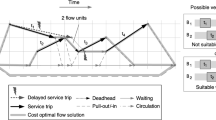Abstract
This paper deals with models, relaxations, and algorithms for an integrated approach to vehicle and crew scheduling for an urban mass transit system with a single depot. We discuss potential benefits of integration and provide an overview of the literature which considers mainly partial integration. Our approach is new in the sense that we can tackle integrated vehicle and crew scheduling problems of practical size.
We propose new mathematical formulations for integrated vehicle and crew scheduling problems and we discuss corresponding Lagrangian relaxations and Lagrangian heuristics. To solve the Lagrangian relaxations, we use column generation applied to set partitioning type of models. The paper is concluded with a computational study using real life data, which shows the applicability of the proposed techniques to practical problems. Furthermore, we also address the effectiveness of integration in different situations.
Similar content being viewed by others
Explore related subjects
Discover the latest articles, news and stories from top researchers in related subjects.REFERENCES
Ball, M., L. Bodin, and R. Dial, “A matching based heuristic for scheduling mass transit crews and vehicles,” Transport. Sci., 17, 4-31 (1983).
Barnhart, C., E. L. Johnson, G. L. Nemhauser, M. W. P. Savelsbergh, and P. H. Vance, “Branch-and-price: Column generation for solving huge integer programs,” Oper. Res., 46, 316-329 (1998).
Beasley, J. E., “Lagrangean relaxation,” in C. R. Reeves (ed.), Modern Heuristic Techniques for Combinatorial Problems, McGraw-Hill, London, 1995, pp. 243-303.
Bodin, L., B. Golden, A. Assad, and M. Ball, “Routing and scheduling of vehicles and crews: The state of the art,” Comput. Oper. Res., 10(2), 63-211 (1983).
Caprara, A., M. Fischetti, and P. Toth, “A heuristic algorithm for the set covering problem,” Oper. Res., 47, 730-743 (1999).
Carraresi, P., L. Girardi, and M. Nonato, “Network models, Lagrangean relaxation and subgradients bundle approach in crew scheduling problems,” in J. R. Daduna I. Branco, J. M. Pinto Paixão (eds.), Computer-Aided Transit Scheduling: Proceedings of the Sixth International Workshop, Springer Verlag, Berlin, 1995, pp. 188-212.
Darby-Dowman, K., J. K. Jachnik, R. L. Lewis, and G. Mitra, “Integrated decision support systems for urban transport scheduling: Discussion of implementation and experience,” in J. R. Daduna and A. Wren (eds.), Computer-Aided Transit Scheduling: Proceedings of the Fourth International Workshop, Springer Verlag, Berlin, 1988, pp. 226-239.
Desrochers, M., “Shortest path problems with resource constraints,” Technical Report GERAD G-88-27. École des Hautes Études Commerciales, Montréal, 1988.
Desrochers, M. and F. Soumis, “A column generation approach to the urban transit crew scheduling problem,” Transport. Sci., 23, 1-13 (1989).
Falkner, J. C. and D. M. Ryan, “Express: Set partitioning for bus crew scheduling in Christchurch,” in M. Desrochers J. M. Rousseau (eds.), Computer-Aided Scheduling: Proceedings of the Fifth International Workshop, Springer Verlag, Berlin, 1992, pp. 359-378.
Fisher, M. L., “The Lagrangian relaxation method for solving integer programming problems,” Manag. Sci., 27, 1-18 (1981).
Freling, R. “Models and Techniques for Integrating Vehicle and Crew Scheduling,” Tinbergen Institute, Erasmus University Rotterdam, 1997.
Freling, R., C. G. E. Boender, and J. M. Pinto Paixão, “An integrated approach to vehicle and crew scheduling,” Technical Report 9503/A. Econometric Institute, Erasmus University Rotterdam, Rotterdam, 1995.
Freling, R., D. Huisman, and A. P. M. Wagelmans, “Applying an integrated approach to vehicle and crew scheduling in practice,” in S. Voß and J. R. Daduna (eds.), Computer-Aided Scheduling of Public Transport, Springer, Berlin, 2001, pp. 73-90.
Freling, R., J. M. Pinto Paixão, and A. P. M. Wagelmans, “Models and algorithms for vehicle scheduling,” Transport. Sci., 35, 165-180 (2001).
Freling, R., A. P. M. Wagelmans, and J. M. Pinto Paixão, “An overview of models and techniques for integrating vehicle and crew scheduling,” in N. H. M. Wilson (ed.), Computer-Aided Transit Scheduling, Springer Verlag, Berlin, 1999, pp. 441-460.
Gaffi, A. and M. Nonato, “An integrated approach to extra-urban crew and vehicle scheduling,” in N. H. M. Wilson (ed.), Computer-Aided Transit Scheduling, Springer Verlag, Berlin, 1999, pp. 103-128.
Geoffrion, A. M., “Lagrangean relaxation for integer programming,” Math. Program. Study, 2, 82-114 (1974).
Haase, K. and C. Friberg, “An exact branch and cut algorithm for the vehicle and crew scheduling problem,” in N. H. M. Wilson (ed.), Computer-Aided Transit Scheduling, Springer Verlag, Berlin, 1999, pp. 63-80.
Haase, K., G. Desaulniers and J. Desrosiers, “Simultaneous vehicle and crew scheduling in urban mass transit systems,” Transport. Sci., 35(3), 286-303 (2001).
Huisman, D., “A note on model VCSP1,” World Wide Web, http://www.few.eur.nl/few/people/huisman/publications.htm, 2000.
Klabjan, D., E. L. Johnson, G. L. Nemhauser, E. Gelman, and S. Ramaswamy, “Airline crew scheduling with time windows and plane count constraints,”. Transport. Sci., 36, 337-348 (2002).
Patrikalakis, I. and D. Xerocostas, “A new decomposition scheme of the urban public transport scheduling problem,” in M. Desrochers and J. M. Rousseau (eds.), Computer-Aided Transit Scheduling: Proceedings of the Fifth International Workshop, Springer Verlag, Berlin, 1992, pp. 407-425.
Rousseau, J.M. and J. Y. Blais, “Hastus: An interactive system for buses and crew scheduling,” in J. M. Rousseau (ed.), Computer Scheduling of Public Transport 2, North Holland, Amsterdam, 1985, pp. 45-60.
Scott, D., “A large linear programming approach to the public transport scheduling and cost model,” in J. M. Rousseau (ed.), Computer Scheduling of Public Transport 2, North Holland, Amsterdam 1985, pp. 473-491.
Tosini, E. and C. Vercellis, “An interactive system for extra-urban vehicle and crew scheduling problems,” in J. R. Daduna and A. Wren (eds.), Computer-Aided Transit Scheduling: Proceedings of the Fourth International Workshop, Springer Verlag, Berlin, 1988, pp. 41-53.
Author information
Authors and Affiliations
Rights and permissions
About this article
Cite this article
Freling, R., Huisman, D. & Wagelmans, A.P.M. Models and Algorithms for Integration of Vehicle and Crew Scheduling. Journal of Scheduling 6, 63–85 (2003). https://doi.org/10.1023/A:1022287504028
Issue Date:
DOI: https://doi.org/10.1023/A:1022287504028




